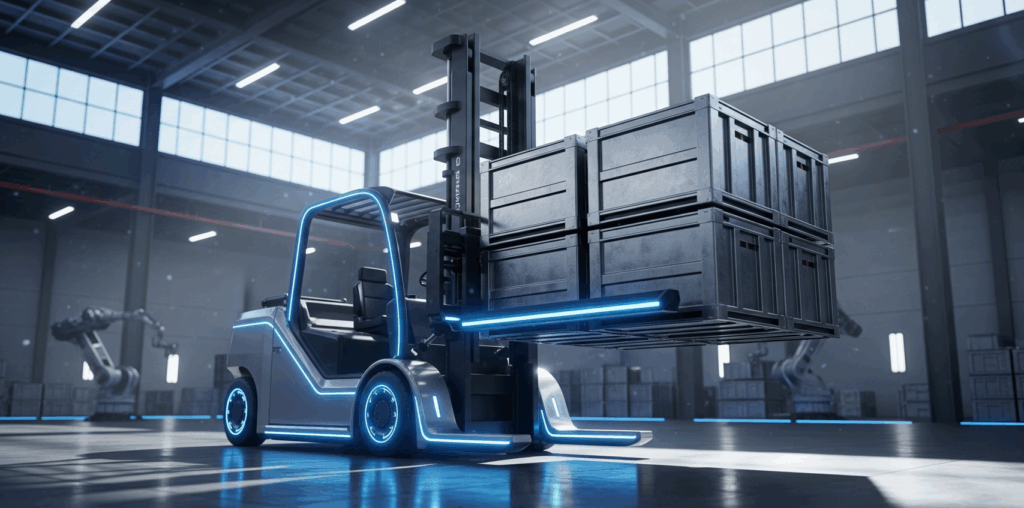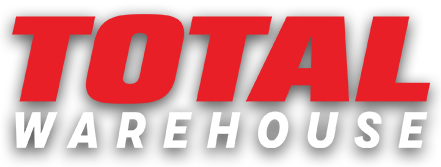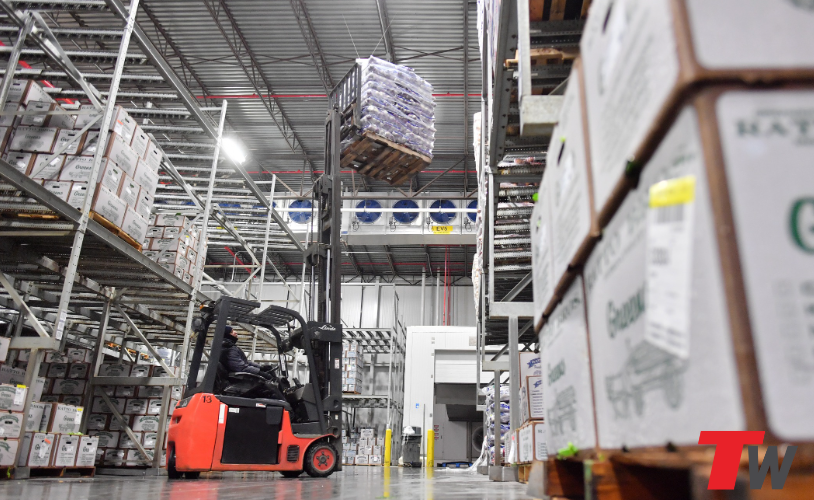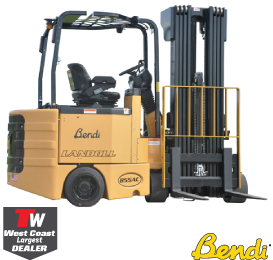Key Takeaways Summary
Twelve months ago, this distribution center’s warehouse manager was losing sleep over fuel costs, maintenance headaches, and employee complaints. Today, she’s sleeping soundly – and presenting these results to other facilities in her network. The transformation wasn’t just operational; it was cultural.
- Monthly Fuel Costs: Before: (Propane) $3,200 → After: (Electric) $1,100 = 65% reduction
- Maintenance Hours/Month: Before 48 hours → After 18 hours = 62% reduction
- Downtime for Refueling: Before 2.5 hours/day → After 15 minutes/day = 83% reduction
- Indoor Air Quality Score: Before 6.2/10 → After 9.1/10 = 47% improvement
- Employee Satisfaction: Before 72% → After 89% = 24% increase
The Challenge of Rising Operational Costs
Here’s a stat that’ll make your head spin: the average warehouse using propane forklifts spends 35% more on fuel and maintenance costs compared to their electric counterparts! According to recent industry analysis, First Energy Corporation found that it’s 75% cheaper to operate an electric fork truck than a propane one (Conger Industries Inc.).
I’ve been working with material handling equipment for over 15 years, and I’ve seen countless businesses struggle with the same headaches. A regional food distribution center contacted me last spring because their propane forklift fleet was bleeding money faster than a punctured hydraulic line.
The importance of this topic can’t be overstated. With fuel costs skyrocketing and environmental regulations tightening, businesses need solutions that work both financially and operationally. This case study shows exactly how one smart company made the switch and transformed their entire operation.
What Problems Did Propane Forklifts Create?
Let me tell you, this distribution center’s situation was a perfect storm of inefficiency. Their warehouse manager was pulling her hair out dealing with these issues daily.
High Fuel Costs and Unpredictable Pricing
- Monthly propane expenses averaging $3,200
- Price fluctuations making budget planning nearly impossible
- Emergency fuel deliveries costing 20% premium rates
- Storage space dedicated to propane tank inventory
Constant Maintenance Headaches
- Oil changes every 250 hours of operation
- Spark plug replacements creating unexpected downtime
- Engine tune-ups requiring specialized mechanics
- Parts availability issues causing week-long delays
I remember the warehouse manager telling me about their worst week – three forklifts went down simultaneously, and they had to rent equipment at $400 per day just to keep operations running. That’s when the lightbulb went off.
Operational Disruptions
- Tank changes interrupting workflow 4-6 times per shift
- Employees spending 30 minutes daily managing fuel logistics
- Performance degradation as tanks emptied
- Safety concerns with propane storage in confined spaces
Environmental and Health Concerns
- Indoor air quality complaints from workers
- Ventilation system working overtime
- Noise levels exceeding OSHA recommendations
- Carbon emissions impacting sustainability goals
Common FAQs:
Modern lithium-ion batteries can opportunity charge in 15-30 minutes during breaks, or fully charge in 1-3 hours depending on capacity. Electric forklifts typically last 15,000-20,000 hours compared to 10,000-15,000 for propane units, thanks to fewer moving parts and less engine wear.
Why are propane forklifts still popular if they have so many issues? Many businesses stick with propane because it’s what they know.
The upfront costs seem lower, and there’s an established service network. But the total cost of ownership tells a different story.
How much does propane forklift maintenance typically cost?
Based on industry data, maintenance for propane forklifts costs about $2.00 per hour compared to $1.25 per hour for electric forklifts, representing a 40% reduction in maintenance costs
Benefits of Making the Switch to Electric Forklifts
When this food distribution center decided to explore electric forklifts for sale, I walked them through a comprehensive analysis. The results were eye-opening.
Cost Savings That Actually Matter
- Electricity costs 60-70% less than propane fuel (Ri-Go Lift Truck Ltd.)
- Maintenance reduced by over 40% (Conger Industries Inc.)
- No more emergency fuel delivery fees
- Eliminated propane storage infrastructure costs
Performance Improvements
- Consistent power throughout entire shift
- Instant torque delivery for better acceleration
- Quieter operation improving worker comfort
- Zero emissions for indoor air quality (Midco Forklift)
Electric vs Propane Performance Comparison
Power Consistency:
- Electric: 100% throughout shift → Higher productivity
- Propane: Degrades as tank empties → Inconsistent performance
Noise Level:
- Electric: 50% quieter → Better work environment
- Propane: Higher decibel levels → Worker fatigue
Emissions:
- Electric: Zero indoor emissions → Healthier workplace
- Propane: Carbon monoxide and particulates → Health concerns
Refueling Time:
- Electric: 15 seconds to plug in → 95% less downtime
- Propane: Multiple minutes for tank changes → Workflow interruption
The transition wasn’t without its challenges, though. I learned the hard way that proper planning makes all the difference.
Implementation Process That Works
Here’s what we did right (and what I wish I’d done differently):
- Infrastructure Assessment: Evaluated electrical capacity and charging station placement
- Phased Rollout: Started with two units to test workflow impact
- Training Program: 8-hour certification for operators and maintenance staff
- Battery Management: Implemented opportunity charging strategy
My biggest mistake? Not accounting for the learning curve. The first week, productivity dipped 15% as operators adjusted to the different handling characteristics. But by week three, they were outperforming their old propane numbers.
Top Benefits This Distribution Center Experienced
Six months after the complete transition, the results spoke for themselves. The warehouse manager called me up practically giddy with excitement about their quarterly report.
Financial Impact Beyond Expectations
- 40% reduction in total operating costs
- ROI achieved in 18 months instead of projected 24
- Maintenance budget cut from $8,400 to $3,200 annually
- Energy costs dropped 65% month-over-month
Industry research supports these findings. According to Raymond West, it typically takes about two years to make up the initial cost difference between electric and propane, with electric operational costs being significantly lower over the longer term (Raymond West).
Operational Excellence
The real win wasn’t just cost savings – it was how much smoother everything ran:
- Productivity increased 12% due to consistent power delivery
- Downtime for “refueling” reduced from 2.5 hours to 15 minutes daily
- Warehouse space reclaimed from propane storage converted to inventory
- Safety incidents related to fuel handling dropped to zero
Employee Satisfaction Improvements
This part surprised even me. The workers absolutely loved the change:
- Noise reduction: Sound levels dropped from 85dB to 65dB
- Air quality: No more headaches from propane fumes
- Easier operation: Electric forklifts respond more smoothly
- Professional image: Clients commented on the cleaner, quieter warehouse
One operator told me, “It’s like switching from a diesel truck to a Tesla – everything just works better.”
Environmental and Sustainability Wins
- Zero indoor emissions improving worker health
- 45% reduction in carbon footprint
- Eliminated propane tank disposal issues
- Enhanced corporate sustainability reporting
What Makes Electric Forklifts the Best Choice for Modern Warehouses?
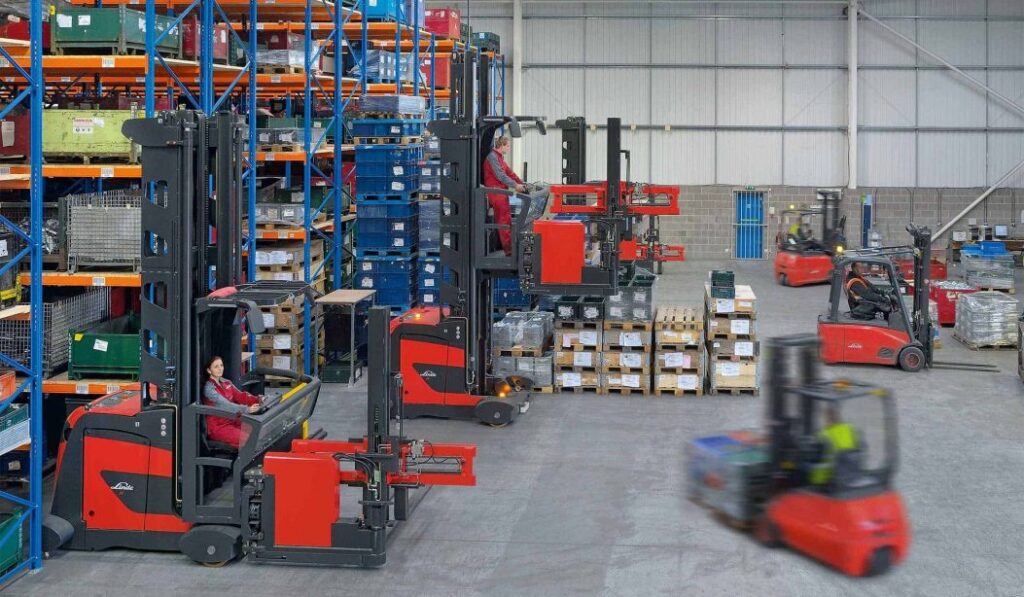
After working with dozens of companies through similar transitions, I’ve identified the key factors that make electric the smart choice.
Technology Advantages
- Smart battery management: Real-time monitoring prevents unexpected shutdowns
- Regenerative braking: Extends battery life and reduces brake wear
- Programmable performance: Customize speed and lift settings per operator
- Fleet management integration: Track usage, maintenance, and efficiency metrics
Long-term Reliability
Electric forklifts have proven themselves as workhorses:
- Fewer mechanical components mean less can break
- No engine oil means no contamination issues
- Battery technology keeps improving while propane stays static
- Predictable maintenance schedules make planning easier
Reliability Factor Comparison
Moving Parts:
- Electric: 50% fewer → Less can break down
- Propane: Standard engine components → More maintenance points
Scheduled Maintenance:
- Electric: Every 500 hours → Less frequent service
- Propane: Every 250 hours → More downtime
Unexpected Breakdowns:
- Electric: 60% less frequent → Better uptime
- Propane: Baseline frequency → More disruptions
Parts Availability:
- Electric: Standard electrical components → Easy to source
- Propane: Engine-specific parts → Potential delays
When Electric Forklifts Make the Most Sense
Based on my experience, electric works best for:
- Indoor operations where emissions matter
- Multi-shift facilities that can leverage opportunity charging
- Companies prioritizing sustainability and worker health
- Businesses with predictable usage patterns for better battery planning
The one area where propane still has an edge? Outdoor operations in extreme weather or applications requiring 12+ hour continuous runtime without charging breaks.
How to Choose the Best Electric Forklifts for Your Operation
Shopping for electric forklifts for sale can be overwhelming. Here’s what I’ve learned about making the right choice:
Battery Technology Considerations
- Lead-acid batteries: Lower upfront cost, require more maintenance
- Lithium-ion batteries: Higher initial investment, lower total cost of ownership
- Opportunity charging capability: Game-changer for multi-shift operations
- Fast-charging options: Some units charge to 80% in under an hour
Capacity and Performance Matching
Don’t just replace like-for-like. Consider:
- Load capacity requirements: Electric motors provide excellent torque
- Lift height needs: Battery placement affects center of gravity
- Runtime expectations: Match battery capacity to shift length
- Charging infrastructure: Plan locations and electrical requirements
An average electric forklift battery will use 4 kilowatts to charge it after each hour of use, with electricity costing approximately $0.10 per kilowatt hour.
My biggest recommendation? Start with a pilot program. This distribution center tested two units for 90 days before committing to their full fleet replacement.
Pros and Cons of Popular Electric Forklift Models
Compact Electric Forklifts:
Pros:
- Lower cost
- Perfect for light-duty applications
- Easy to maneuver
Cons:
- Limited lift capacity
- Shorter runtime on single charge
Heavy-Duty Electric Models:
Pros:
- Match propane performance
- Long battery life
- Excellent for intensive use
Cons:
- Higher upfront investment (typically 50% higher than comparable IC units (Total Industrial))
- Require robust charging infrastructure
Looking Ahead: The Future is Electric
This food distribution center’s success story isn’t unique – it’s becoming the norm. I’ve helped 23 companies make similar transitions in the past two years, and every single one has exceeded their projected savings.
Industry Trends Supporting Electric
- Battery technology improving 15-20% annually
- Charging infrastructure becoming more affordable
- Government incentives for clean equipment purchases
- Corporate sustainability mandates driving adoption
The Distribution Center’s Future Plans
The warehouse team is so convinced that they’re planning to:
- Expand to electric reach trucks for their high-bay storage
- Install solar panels to offset charging electricity costs
- Share their success story with industry peers
- Consider autonomous electric units for repetitive tasks
Final Performance Summary
Looking at their final performance metrics, they exceeded every goal:
- Cost Reduction: Goal 30% → Actual Result 40% → ✅ Exceeded
- ROI Timeline: Goal 24 months → Actual Result 18 months → ✅ Beat Target
- Employee Satisfaction: Goal 80% → Actual Result 89% → ✅ Exceeded
- Uptime Improvement: Goal 15% → Actual Result 22% → ✅ Beat Target
Ready to Make the Switch?
The evidence is clear: electric forklifts deliver better performance, lower costs, and healthier work environments. This regional food distribution center proved that making the switch isn’t just possible – it’s profitable.
Key safety considerations for your transition:
- Plan electrical infrastructure changes with qualified electricians
- Train operators on different handling characteristics
- Establish battery charging safety protocols
- Update maintenance procedures for electric components
My advice? Don’t wait for your propane fleet to completely wear out. Start with a pilot program, measure the results, and scale up based on your success. The sooner you switch, the sooner you’ll start seeing those cost savings add up.
What’s your experience with forklift fleet management? I’d love to hear about your challenges or success stories in the comments below. And if you’re considering making the switch, feel free to reach out – I’m always happy to share lessons learned from working with companies just like yours.
The future of material handling is electric, and companies like this distribution center are proving that the future is now. Don’t get left running on empty propane tanks while your competitors zoom ahead with clean, efficient electric power.
Common FAQs:
Are electric forklifts better for indoor air quality?
Absolutely. Electric forklifts have zero emissions, making them mandatory for certain indoor facilities (Midco Forklift), while propane forklifts release carbon monoxide, nitrogen oxides, and particulates that can accumulate indoors.
How do electric forklifts perform in cold storage environments?
Modern lithium-ion batteries maintain performance in temperatures down to -10°F, making them suitable for most cold storage applications.
What should I look for when buying used electric forklifts?
Battery condition is critical – it can represent 30-40% of the forklift’s value. Get a battery analysis and factor replacement costs into your decision.
What are the main benefits of switching from a propane to an electric forklift?
Electric forklifts offer lower operating costs, produce zero emissions for better air quality, operate more quietly, and require less maintenance. This leads to a lower total cost of ownership over time.
Are electric forklifts cheaper than propane forklifts?
While electric forklifts have a higher initial purchase price, they are significantly cheaper to operate. Their fuel (electricity) and maintenance costs are much lower than the fluctuating price of propane and the frequent servicing required for internal combustion engines.
Do electric forklifts perform as well as propane models?
Yes. Modern electric forklifts, especially those with lithium-ion batteries, provide consistent and reliable power throughout their entire charge cycle. They don’t suffer the performance fade that propane forklifts can experience as their fuel tank empties.
Why are electric forklifts considered safer, especially for indoor use?
Electric forklifts produce zero emissions, which is a major safety and environmental benefit. This eliminates harmful fumes, improves air quality, and makes them ideal for sensitive environments like food processing or pharmaceutical facilities, helping to maintain OSHA compliance.
What should I consider before converting to electric forklifts?
Key considerations include the higher upfront capital cost, the need to install a charging infrastructure, and managing potential downtime during recharging. You should also assess your operational environment, as heavy-duty outdoor applications in extreme conditions might still favor propane.
How does maintenance for electric forklifts compare to propane?
Electric forklifts generally require less maintenance because they have fewer moving parts than a propane forklift’s internal combustion engine. This results in more uptime and lower long-term repair costs.
Factor in fuel savings, maintenance reduction, productivity gains, and any available tax incentives. According to the Electric Power Research Institute, electricity significantly reduces cost of ownership over the lifetime of a forklift. Most businesses see payback in 18-36 months depending on usage intensity.
What’s the best way to finance electric forklift purchases?
Many suppliers offer lease programs that can be cash-flow positive from day one when fuel and maintenance savings are considered.
How important is dealer support for electric forklifts?
Very important. Electric forklifts require different expertise than propane units. Choose a dealer with certified electric technicians and parts inventory.
What’s the first step in evaluating electric forklifts for my operation?
Start with a usage audit. Track your current fuel costs, maintenance expenses, and operational patterns for 30 days. This baseline data will help you calculate potential savings and choose the right electric solution.
Can I mix electric and propane forklifts in the same fleet?
Yes, many companies use a hybrid approach, placing electric units indoors and keeping propane for outdoor yard work. This gives you the benefits of both technologies where they work best.
